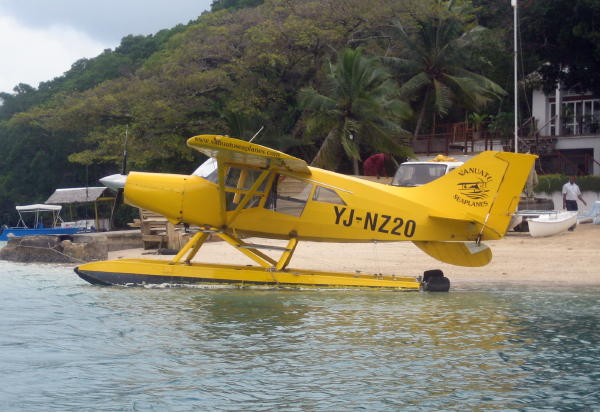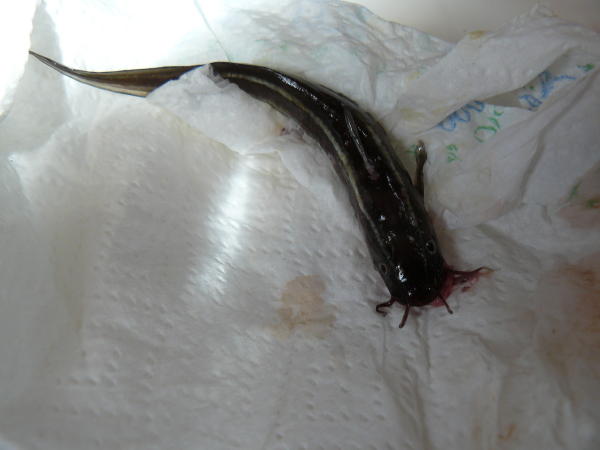Vanuatu (with photos)

JJMoon Diary
Barry and Margaret Wilmshurst
Wed 6 Aug 2008 04:12
|
When last heard from we were pottering
along delaying our arrival in Port Vila until daylight. This worked
according to plan and we have just come to the end of a most enjoyable
three weeks chilling out in and around the capital of Vanuatu on the island of
Efate.
Vanuatu is interesting and of course we
knew nothing about the country before coming here and even now are woefully
ignorant. The people speak English better than the Fijians (one is
greeted with "alo" by everyone , rather than "bula"). Everything is very
south-seas English except that they drive on the right, most official
signs include a French translation and the goods in the supermarkets
and food in the restaurants carry a very beneficial French influence. Not
too bad then! The country had a rather complicated history during the
years leading up to independence in 1980. Before that the islands were
known by Captain Cook's name "The New Hebredies". From 1926 the
country was a condominium administered jointly by Britain and
France. There were two languages, two sets of laws, two police forces and
two of quite a bit else. The locals knew it as a "pandemonium" but
it doesn't seem to have soured their sunny natures. Having thoroughly
enjoyed "city" life we are now anchored in a quiet bay about twenty-five miles
away, still on Efate, but headed towards some of the other islands where we are
told there will be interesting experiences amid traditional culture.
The passage over from Lautoka, Fiji,
comprised 4 days of Force 6/7, over the quarter so no problem in itself but
enough high swell to throw everything about much of the time which resulted in
water in the bilges (I think it backs up through the discharge pipes and
eventually blows the fuses on the pumps - interesting!), broken
crockery and very interrupted sleep. We didn't think too much about it
while at sea but we later learned that other boats had had a very miserable time
of it, trying unsuccessfully to turn back, diverting from original destinations
and so forth, so that then we felt quite sorry for ourselves.
However, it was very comfortable in Port Vila on a laid mooring
in the sheltered inner harbour, said to be safe in all but the severest
cyclones.
On arrival there we called up to announce
our presence and arrange customs clearance and a berth. Our call was
overheard by a fellow yachtsman who turned out to be the Ocean Cruising Club's
Rear Commodore, Australia. He said he had been looking out for us and
after an initial chat on the radio he and his wife turned up half an hour later
with a loaf of bread. "Ah", he said "the famous JJ Moon". Eh,
what? Famous? Where, why? It seems that he keeps his boat
in Sydney just a few metres from our friends Norrey and Richard who
took us out on their very impressive power boat last Boxing Day. They are
good mates and the Rear Commodore had been asked to look out for
us. Excellent people - serious sailors with a light touch. As they
left the moorings and motored down the habour waving to friends on the boats and
in the bar they were observed to be followed at five metres' distance
by a life sized duck bobbing in their wake. One cause of slight discontent is that we
have been caught up again and enveloped by both the ARC World Rally and the
Blue Water Rally. Several of the Blue Water boats were being hauled out at
Vuda Point when we left Fiji and on arrival in Port Vila big ARC boats
were taking up nearly all available space. Once they had left part of the
Blue Water arrived. We understand that there is no love lost between these
armadas. Some of the ARC skippers were so pushy as to be
obnoxious. We chatted to the owners of one the smallest (according to
the skipper) of the Blue Water boats in Vuda. They seemed to be
rather disillusioned. I should like to have met them a second
time so that I could advise them to duck out despite the substantial sums
already spent. After getting half way round in their 30 year old
Laurent Giles motor sailor they realise that they could have done it on their
own. What they perhaps do not quite appreciate is that once they were on
their own they would soon build up a community of friends doing much the same
thing, travelling in much the same direction, who would be a great source of
moral and practical support. On the other hand we later had a couple
of chats over evening drinks with the owners of a Contest 48 who gave a very
positive picture of the Blue Water Rally. Their only gripe was with
the rapidity with which they were being hurried along but they pointed out
that it was this very speed which attracted many busy people in mid-life to take
two years out and "do the world".
It is a tradition out here in the south
seas to entertain holidaymakers by taking them for a short flip in a
seaplane. We decided to give this one a miss. It has a mooring close
to where Y-Not was tied up and Ross observed the owner carrying
out essential maintenance. Five times he taxied to the shore, threw
the engine cowling on to the beach, applied himself to vigorous spanner work,
replaced the cowling and taxied off. Each time he revved up, the engine
faltered and he returned to the beach. In between sessions with the
spanners he was bailing out the floats with a hand pump. Bearing in mind
the fickleness of the engine and the power lines stretched across his flight
path we came to the conclusion that a gale in the Tasman Sea offered us better
odds.
 Not that we have anything to crow about
on the maintenance front. As ever we are beset with minor problems.
A few days ago we were running the water maker when the pump started to
race. I quickly saw that there was no sea water reaching the machine and
after finding the coarse strainer clear of debris suspected a plastic bag caught
in the inlet. I popped over the side and could see the inlet in the clear
water but could not get close enough for long enough to probe with a suitable
piece of bent wire. The mate got ready her sophisticated scuba gear but
before undoing all the good of her early morning shower and hair wash I undid
the relevent pipe joints inside the boat. Here I discovered this ugly
little critur. He had swum into the skin fitting, through the sea
cock, turned a right angle and reached the end of his road with his nose in
the mouth of the strainer. He was such a perfect fit in the pipe that not
a drop was getting past. We also have trouble with the bilge pumps; an
intermittent fault at start-up with the
generator......................
 Ugh! It was this chap
that gummed up our water maker.
We have managed
to accomplish some interesting sight-seeing. The local
water falls were very attractive in a low-key way and the studio and exhibition
of a couple of local south-west Pacific artists was well worth a visit.
Not so worthy, but just as enjoyable, have been some great meals, for example
the Sunday lunchtime mud crabs illustrated. What a mess we got into!
Memorable!
We learn that the first American landing
in the SW Pacific during the war was very close to the Port Vila
moorings. As it turned out the Japanese hadn't arrived, so the Americans
decided it was a practice run. They then created a huge base to hide
submarines and planes and disguised the latter with a very fast growing
creeper. In order to direct their own planes to the air strip they
bull-dozed 3 huge sand dunes in the shapes USA and of course
these are still there as is the rampant creeper which has obliterated whole
tracts in impenetratable jungle. Local taxi drivers point these things out
with grim disatisfaction.
Having spent the day here in Sema Bay on
Efate we intend to travel overnight to the island of Epi where there is to be a
race of local outrigger canoes on Friday. The distance to Epi, 65 miles,
is just too far for us to be sure of reaching the anchorage in daylight so
we leave at 1700, which should give us a hour's daylight to get through the pass
and then we shall have to slow down a bit in order to reach the anchorage just
after first light.
|